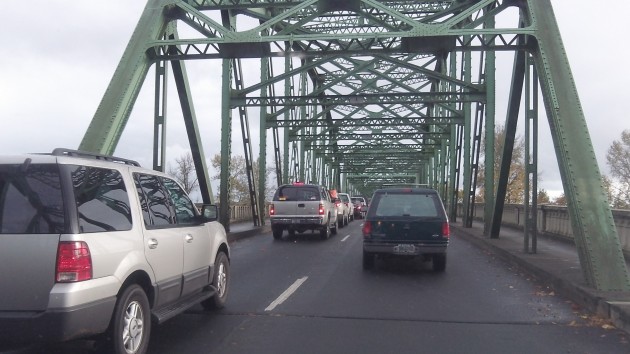Oregon’s voluntary road user fee program is puttering along, having produced at least one surprise, and my question is: Now what? Will Oregon take the next step and go for a mandatory system of paying road taxes by the mile?
The voluntary program, affectionately known as OReGO, is charging participants like me 1.5 cents a mile we drive and refunding the 30-cent-per-gallon state tax we paid when we bought gas.
The legislature authorized up to 5,000 participants for this first-in-the-nation large-scale test of a mileage tax for roads. But as of Nov. 13, only 953 had signed up since the program began in June. On Monday, ODOT’s Michelle Godfrey told me there were 958 volunteers, so five more had enrolled. That’s why I say the program is puttering along, not speeding by any means.
More than 400 volunteer vehicles in OReGO get more than 22 miles per gallon, and the most-enrolled vehicle is a Toyota Prius, the Road User Fee Task Force learned when it met on Nov. 18. That was a surprise, at least to me, because I had assumed owners of high-mileage vehicles would not volunteer for a program forcing them to pay more for roads. I guess a lot of Prius owners are more generous or public-spirited than I had assumed. Or they just have more money to spend.
The Prius people, by the way, were followed by owners of F150 trucks and Subaru Outbacks.
Of all the 950-plus participants, the largest single number, 225, was from Multnomah County. Washington County was second with 154. In Benton County, we have 44, and in Linn there are 20, according to the Nov. 13 report.
I asked about the money angle. Godfrey says the system has produced revenue, though the amount so far “was fairly negligible given the small number of participants.” Whatever the revenue was, it presumably came from the Prius owners. None of it was from me. I had enrolled my 2007 GMC pickup in the program, and as of Tuesday OReGO owed me $9.74 in excess gas tax. I won’t get it until the amount reaches $25, so I’ll have to put more miles on that truck.
What’s next? At the Nov. 18 meeting, the Road User Fee Task Force learned ODOT was working on an updated model to predict the costs and revenues of the fuels tax and other revenue sources. “The update,” the report in the agenda said, “is expected to produce a tool that ODOT can use to support (task force) policy recommendation considerations and discussions with legislators, state officials and other policy and decision makers around a potential mandatory road usage charge program.”
Among other things to be considered: Should the mileage tax be a flat amount as now (1.5 cents a mile), or should it vary depending on the vehicle? Should it apply to all vehicles or just those weighing less than 26,000 pounds? And should be be imposed all at once, or gradually, in steps? The task force was created in 2001 to look for alternatives to the gas tax as a means to fund our roads, and it may take many more years to settle these and other questions.
One member of the public, a retired satellite communications engineer, told the task force the current system, relying on sensors in vehicles and cell-phone band width to report distance driven and gas consumed, was way too complicated and costly. He suggested a simpler way: Have vehicle owners self-report their mileage on their tax returns. (hh)



OReGO would only be fair if the per-mile charge depended on vehicle factors which influence road wear: obviously weight, but also studded tires, and other things which don’t immediately come to mind.
If we trust income tax to self-reporting (with the partially credible threat of audits), why not this?
But, I have a better idea. Forget gallons and miles, and tax congestion instead. For example, if you want to cross the Van Buren bridge on weekdays at 5 PM and become part of the former traffic jam at the subsequent light, you pay a toll (which should vary with vehicle size). Importantly, the toll price would be whatever it takes to keep traffic flowing smoothly everywhere. And that, I contend, would be worth it for the vast majority of drivers. Those who don’t want to pay have many choices: car pool (with discounted tolls), bus, bike, get the boss to change work hours, etc.
The inspiration is a book “The High Cost of Free Parking” by Donald Shoup (I love the title, haven’t read it yet) which advocates having parking meter prices shift upward and downward so there is almost always an optimum percentage of spaces available, so no one needs to waste a lot of time and gas, and produce a lot of pollution, to find one.
But, wait, it gets still better. By using an economic nudge to keep traffic within the existing capacity, it becomes possible to spend much more on maintaining the existing infrastructure and much less on new construction so very expensive in mature cities. In the same way, free buses and extensive bike paths pay for themselves by removing just a few cars which clogged the roads at the wrong time.
Just to clarify: “new construction” in the last paragraph meant capacity expansion, not replacement due to structural deficiency.
They’re kicking around ideas about congestion pricing as well. (hh)
How about doing away with studded tires?! New rubber technology has brought us compounds that perform rather well on ice & really good in snow. Studded tires had their 15 minutes of fame & are continually destroying our roads to this day!
As for “self reporting” mileage, owing to human nature to on the one hand to exaggerate & on the other hand under estimate I’d favor (aww) a device that would be down loaded at your local tax source that does taxes!..JE